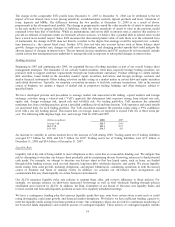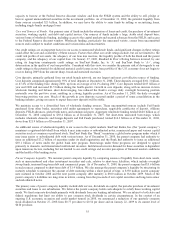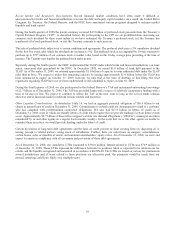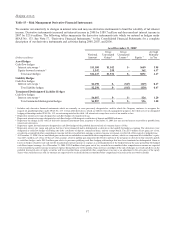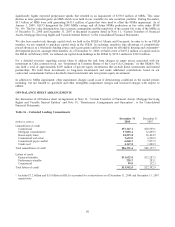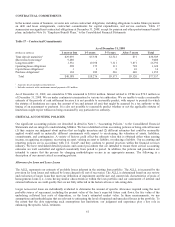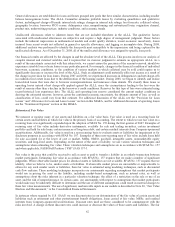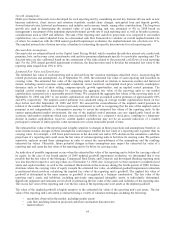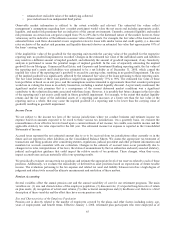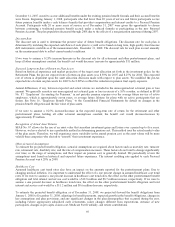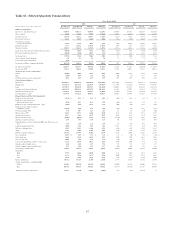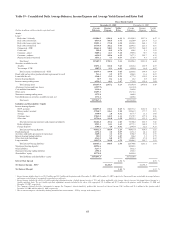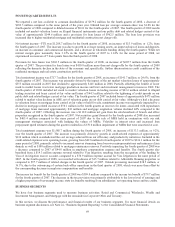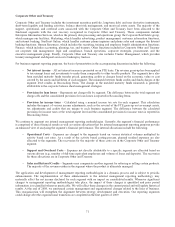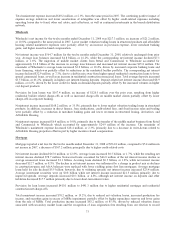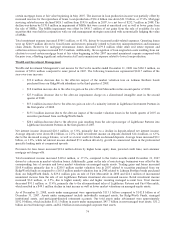SunTrust 2008 Annual Report Download - page 76
Download and view the complete annual report
Please find page 76 of the 2008 SunTrust annual report below. You can navigate through the pages in the report by either clicking on the pages listed below, or by using the keyword search tool below to find specific information within the annual report.Growth Assumptions
Multi-year financial forecasts were developed for each reporting unit by considering several key business drivers such as new
business initiatives, client service and retention standards, market share changes, anticipated loan and deposit growth,
forward interest rates, historical performance, and industry and economic trends, among other considerations. The long-term
growth rate used in determining the terminal value of each reporting unit was estimated at 4% in 2008 based on
management’s assessment of the minimum expected terminal growth rate of each reporting unit, as well as broader economic
considerations such as GDP and inflation. The sum of the reporting unit cash flow projections was compared to our market
capitalization, on a control adjusted basis, in a discounted cash flow framework to calculate an overall implied internal rate
of return. In connection with the 2008 annual goodwill impairment evaluation, the implied internal rate of return was 11%.
This implied internal rate of return served as a baseline for estimating the specific discount rate for each reporting unit.
Discount Rate Assumptions
Discount rates are estimated based on the Capital Asset Pricing Model, which considers the risk-free interest rate, market risk
premium, beta, and in some cases, unsystematic risk and size premium adjustments specific to a particular reporting unit. The
discount rates are also calibrated based on the assessment of the risks related to the projected cash flows of each reporting
unit. For the 2008 annual goodwill impairment evaluation, the discount rates used to develop the estimated fair value of the
reporting units ranged from 10% to 14%.
Estimated Fair Value and Sensitivities
The estimated fair value of each reporting unit is derived from the valuation techniques described above, incorporating the
related projections and assumptions. As of September 30, 2008, the estimated fair value of each reporting unit exceeded its
carrying value. The estimated fair value of the reporting units is analyzed in relation to numerous market and historical
factors, including current economic and market conditions, recent, historical, and implied stock price volatility, marketplace
dynamics such as level of short selling, company-specific growth opportunities, and an implied control premium. The
implied control premium is determined by comparing the aggregate fair value of the reporting units to our market
capitalization, measured over a reasonable period of time. We compared the aggregate fair values of the reporting units as of
September 30, 2008 and 2007 to our market capitalization and derived an implied control premium of approximately 60%
and 40%, respectively. The implied control premium was calculated using an average market capitalization based on five
days before and after September 30, 2008 and 2007. We assessed the reasonableness of the implied control premium in
relation to the market and historical factors previously mentioned, as well as recognizing that the size of the implied control
premium is not, independently, a determinative measure to assess the estimated fair values of the reporting units. In the
current unprecedented market environment, the size of the implied control premium can vary significantly based on the
economic and market conditions which may cause increased volatility in a company’s stock price, resulting in a temporary
decline in market capitalization; however, current market capitalization may not be an accurate indication of a market
participant’s estimate of entity-specific value measured over a more reasonable period of time.
The estimated fair value of the reporting unit is highly sensitive to changes in these projections and assumptions; therefore, in
some instances minor changes in these assumptions could impact whether the fair value of a reporting unit is greater than its
carrying value. For example, a 100 basis point increase in the discount rate and/or 20% decline in the cumulative cash flow
projections of a reporting unit could cause the fair value of certain reporting units to be below its carrying value. We perform
sensitivity analyses around these assumptions in order to assess the reasonableness of the assumptions and the resulting
estimated fair values. Ultimately, future potential changes in these assumptions may impact the estimated fair value of a
reporting unit and cause the fair value of the reporting unit to be below its carrying value.
An indication of possible impairment occurs when the estimated fair value of the reporting unit is below the carrying value of
its equity. In the case of our fourth quarter of 2008 updated goodwill impairment evaluation, we determined that it was
possible that the fair value of the Mortgage, Commercial Real Estate, and Corporate and Investment Banking reporting units
was less than their respective carrying values as of December 31, 2008, due, in large part, to their exposure to residential real
estate and capital markets, as well as the continued deterioration in the economy during the fourth quarter of 2008. In those
situations where the carrying value of equity exceeds the estimated fair value, an additional goodwill impairment evaluation
is performed which involves calculating the implied fair value of the reporting unit’s goodwill. The implied fair value of
goodwill is determined in the same manner as goodwill is recognized in a business combination. The fair value of the
reporting unit’s assets and liabilities, including previously unrecognized intangible assets, is individually determined.
Significant judgment and estimates are involved in estimating the fair value of the assets and liabilities of the reporting unit.
The excess fair value of the reporting unit over the fair value of the reporting unit’s net assets is the implied goodwill.
The value of the implied goodwill is highly sensitive to the estimated fair value of the reporting unit’s net assets. The fair
value of the reporting unit’s net assets is estimated using a variety of valuation techniques including the following:
• recent data observed in the market, including similar assets
• cash flow modeling based on projected cash flows and market discount rates
• market indices
64


